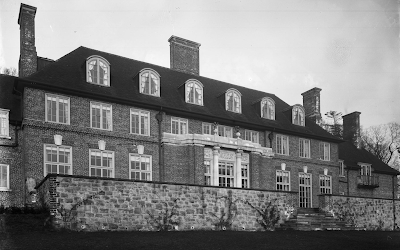This family was originally of Scottish extraction.
DAVID LYONS, of Belfast (son of Thomas Lyons (1624-93), who was buried at Shankill, Belfast), had issue, by Kate his wife,
DAVID, of whom presently;Mr Lyons died in 1717, and was succeeded by his only son,
Anne, m Thomas Foster.
DAVID LYONS (1701-72), of Old Park, Belfast, who wedded firstly, Mary, daughter of Elias Boyd, and had issue.
By his second wife, Jane, he had issue,
THOMAS, of whom presently;Mr Lyons was succeeded by his eldest son,
Henry;
William;
Mary; Anne; Eleanor; Elizabeth; Jane; Sarah.
THOMAS LYONS (1747-1806), of Old Park, who espoused, in 1778, Sarah, daughter of Andrew Armstrong, of Clara, King's County, and Dublin, and had issue,
HENRY, his heir;Mr Lyons was succeeded by his eldest son,
WILLIAM HOLMES, successor to his brother;
Edward Forbes;
Eliza; Juliana.
HENRY LYONS (1779-1839), who died unmarried, and was succeeded by his brother,
WILLIAM HOLMES LYONS (1781-1849), of Old Park, who wedded, in 1810, Anne, daughter of the Rev William Bristow, Vicar of Belfast, and Sovereign of Belfast, by Rose, his wife, daughter of George Cary, of Redcastle, County Donegal, and had issue,
WILLIAM THOMAS BRISTOW, his heir;Mr Lyons was succeeded by his only son,
Sarah (1818-1905).
WILLIAM THOMAS BRISTOW LYONS JP DL (1812-87), of Old Park, Belfast, and Brookhill, Lisburn, High Sheriff of County Antrim, 1866, who married, in 1840, Julia Maria, daughter of James Jones, of Mount Edward, County Sligo, and had issue,
WILLIAM HENRY HOLMES, his heir;Mr Lyons was succeeded by his eldest son,
Robert Colvill Jones, of Lime Hill house, Tunbridge Wells;
Henry Kenneth Thomas, of Denver, USA;
James Bristow;
Clarence Edward;
Eliza; Julia Maria; Dorinda Anna Henrietta; Edith Arabella Louisa Florence;
Constance Adela Hastings; Julie Marie Louise.
THE RT HON WILLIAM HENRY HOLMES LYONS JP DL (1843-1924), of Brookhill, Lisburn, Old Park, Belfast, and Richmond Lodge, County Down, High Sheriff of County Antrim, 1904, Grand Master, Orange Lodge of Ireland, who espoused, in 1888, Mary Eliza (Lily), eldest daughter of George Evans, of Gortmerron House, County Tyrone, and had issue,
WILLIAM HOLMES ST JOHN, his heir;Mr Lyons was succeeded by his only son,
Vera Patricia Mabel; Evyleen Sara Evans; Lily Eileen.
WILLIAM HOLMES ST JOHN LYONS (1888-1918), Lieutenant, Middlesex Regiment, who married, in 1907, Doris Margaret, youngest daughter of George A Walpole FRCS, of Gormanston, Tasmania.
 |
| Old Park House (Image: Richard Graham) |
OLD PARK HOUSE, Belfast, would appear to have been mid-Georgian.
It was built for David Lyons, who also owned a bleach-yard in the Oldpark area of Belfast in the 1750s.
Old Park features in J A K Dean's Plight of the Big House in Northern Ireland, published in 2020.
 |
| Lyons Family Plot at Knockbreda Church-yard |
David Lyons' wife, Mary, had her name recorded at Shankill graveyard in 1739, presumably before he took over or built the bleach-yard.
George Benn, the celebrated Belfast historian, described Old Park thus in 1877:
A beautiful rural home, with fine gardens and trees, and a convenient distance from the "madding crowd." Now, in our time, the 42 acres of which the demesne consists are advertised to be let in lots for villas or streets, which will doubtless be the case in due time.Benn remarked that Old Park had been built a century ago, making its erection in the 1770s.
Old Park remained in the Lyons family until about 1868, when Thomas Lyons moved to Brookhill, near Lisburn, the Belfast boundaries having surpassed the old demesne.
Old Park House subsequently became the property of William Robertson, of Hawkins, Robertson & Ferguson, drapers, of the Bank Buildings, Belfast.
A plaque in the ambulatory of Belfast Cathedral, recording that Mr Lyons lived for some time at Brookhill, Lisburn, was placed in his memory by his mother, Anne.
The plaque was originally in St Anne's parish church.
First published in January, 2013.
Old Park House subsequently became the property of William Robertson, of Hawkins, Robertson & Ferguson, drapers, of the Bank Buildings, Belfast.
A plaque in the ambulatory of Belfast Cathedral, recording that Mr Lyons lived for some time at Brookhill, Lisburn, was placed in his memory by his mother, Anne.
The plaque was originally in St Anne's parish church.
First published in January, 2013.





































